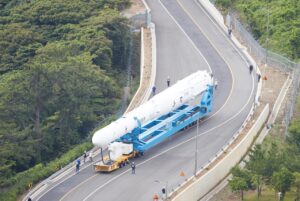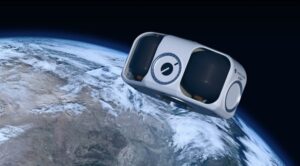4 buildings at observatory in Arizona lost in wildfire
Saturday, 18 June 2022 20:30
Four non-scientific buildings at the Kitt Peak National Observatory southwest of Tucson were lost in a wildfire, but early indications show other buildings on the property didn't appear to be damaged, authorities said Saturday.
Buell T. Jannuzi, who leads the Department of Astronomy at the University of Arizona, said the fire didn't appear to have damaged the telescope and science buildings at the observatory, though a closer examination of the site hadn't yet been made due to safety concerns.
"This is the most threatening fire I can remember at Kitt Peak in the last 25 years," Jannuzi said.
The fire reached the observatory early Friday. Crews were planning to assess the damage at the observatory later Saturday if conditions allowed for safe entry into the area.
Kitt Peak National Observatory is operated by NOIRLab, the National Science Foundation's center for ground-based optical-infrared astronomy. The University of Arizona, which has had a telescope at the site since 1962, is a tenant of the observatory.
The lightning-caused fire, which led to an evacuation of the observatory earlier this week, had grown to 27 square miles (71 kilometers) by Saturday.
Did a giant radio telescope in China just discover aliens? Not so FAST
Saturday, 18 June 2022 00:17 This phrase is the standard that astronomers will be applying to a curious signal captured with China's "Sky Eye" telescope that might be a transmission from alien technology.
An article reporting the signal was posted on the website of China's state-backed Science and Technology Daily newspaper, but was later removed. So have astronomers finally found evidence of intelligent found life be
This phrase is the standard that astronomers will be applying to a curious signal captured with China's "Sky Eye" telescope that might be a transmission from alien technology.
An article reporting the signal was posted on the website of China's state-backed Science and Technology Daily newspaper, but was later removed. So have astronomers finally found evidence of intelligent found life be SpaceX Falcon 9 launches for its 13th time, a record for the company
Saturday, 18 June 2022 00:17 A SpaceX Falcon 9 lifted off on its record 13th launch on Friday afternoon as it sent 53 Starlink satellites into orbit.
The rocket took off from pad 39A at Kennedy Space Center, with the first stage sticking a successful return and landing at the Shortfall of Gravitas drone ship shortly after lift off.
SpaceX said the same first stage booster support was used in the GPS III-3, T
A SpaceX Falcon 9 lifted off on its record 13th launch on Friday afternoon as it sent 53 Starlink satellites into orbit.
The rocket took off from pad 39A at Kennedy Space Center, with the first stage sticking a successful return and landing at the Shortfall of Gravitas drone ship shortly after lift off.
SpaceX said the same first stage booster support was used in the GPS III-3, T Speedcast plotting major satellite capacity expansion
Friday, 17 June 2022 18:44
Remote communications provider Speedcast is preparing to buy another sizable chunk of satellite capacity as demand soars beyond pre-pandemic levels.
The post Speedcast plotting major satellite capacity expansion appeared first on SpaceNews.
South Korean rocket’s second launch rescheduled for June 21
Friday, 17 June 2022 17:29
The second launch of South Korea’s first domestically built rocket is set for June 21, a delay of a week due to strong winds and a technical glitch.
The post South Korean rocket’s second launch rescheduled for June 21 appeared first on SpaceNews.
Impulse Space raises an additional $10 million for orbital transfer vehicles
Friday, 17 June 2022 14:32
In-space transportation company Impulse Space Propulsion, which raised $20 million in a seed round earlier this year, announced June 17 it raised another $10 million to help accelerate work on orbital transfer vehicles.
Getting SSA off the ground
Friday, 17 June 2022 13:43
Investors are funding orbital solutions for tracking space objects.
The post Getting SSA off the ground appeared first on SpaceNews.
Webb's mid-infrared spectroscopy will reveal molecules, elements
Friday, 17 June 2022 12:18
Week in images: 13-17 June 2022
Friday, 17 June 2022 12:03
Week in images: 13-17 June 2022
Discover our week through the lens
SCEYE HAPS ascends to stratosphere demonstrates ability to stay over area of operation
Friday, 17 June 2022 11:45 Sceye, a manufacturer of High-Altitude Platform Stations (HAPS), announced that it reached the stratosphere with the aim of demonstrating the ability to stay over an area of operation for months at a time using renewable energy sources.
The milestone test launch, which is using patented solar and battery power, puts Sceye on track to expand internet access to remote populations, monitor gr
Sceye, a manufacturer of High-Altitude Platform Stations (HAPS), announced that it reached the stratosphere with the aim of demonstrating the ability to stay over an area of operation for months at a time using renewable energy sources.
The milestone test launch, which is using patented solar and battery power, puts Sceye on track to expand internet access to remote populations, monitor gr Airbus built MEASAT-3d communications satellite ready for launch
Friday, 17 June 2022 11:45 The Airbus built MEASAT-3d telecommunications satellite is in Kourou, French Guiana and is ready for its launch on an Ariane 5 on 22 June 2022.
MEASAT-3d is the 57th E3000 satellite built by Airbus and will be positioned at the 91.5E orbital slot and collocated with MEASAT-3b, also built by Airbus.
This new satellite will significantly enhance broadband speeds of up to 100 Mbps in ar
The Airbus built MEASAT-3d telecommunications satellite is in Kourou, French Guiana and is ready for its launch on an Ariane 5 on 22 June 2022.
MEASAT-3d is the 57th E3000 satellite built by Airbus and will be positioned at the 91.5E orbital slot and collocated with MEASAT-3b, also built by Airbus.
This new satellite will significantly enhance broadband speeds of up to 100 Mbps in ar Northrop Grumman runs Laser Communication Demonstration for Tranche 1 constellation
Friday, 17 June 2022 11:45 Northrop Grumman Corporation has announced the successful ground demonstration of a secure networked laser communications system for proliferated-LEO constellations supporting the U.S. military.
Performed for SDA leadership, the demonstration validated compatibility between commercially developed laser communication and secure U.S. government encryption hardware, providing a baseline for N
Northrop Grumman Corporation has announced the successful ground demonstration of a secure networked laser communications system for proliferated-LEO constellations supporting the U.S. military.
Performed for SDA leadership, the demonstration validated compatibility between commercially developed laser communication and secure U.S. government encryption hardware, providing a baseline for N China's deep space exploration laboratory starts operation
Friday, 17 June 2022 11:45 China's deep space exploration laboratory has started operations, the China National Space Administration (CNSA) said Tuesday.
Co-established by the CNSA, Anhui Province and the University of Science and Technology of China, the laboratory is headquartered in Hefei, capital city of Anhui.
It has completed various preparatory work and entered a new stage of substantial operation and c
China's deep space exploration laboratory has started operations, the China National Space Administration (CNSA) said Tuesday.
Co-established by the CNSA, Anhui Province and the University of Science and Technology of China, the laboratory is headquartered in Hefei, capital city of Anhui.
It has completed various preparatory work and entered a new stage of substantial operation and c German radar satellite TerraSAR-X - 15 years in space and still in perfect shape
Friday, 17 June 2022 11:45 Fifteen years - who would have thought it? The German radar satellite TerraSAR-X, which was launched from the Baikonur Cosmodrome in Kazakhstan at 08:14 local time on 15 June 2007, was originally designed to last five and a half years - until the end of 2012. It has been delivering data of outstanding quality ever since, regardless of weather conditions, cloud cover and daylight levels. The scie
Fifteen years - who would have thought it? The German radar satellite TerraSAR-X, which was launched from the Baikonur Cosmodrome in Kazakhstan at 08:14 local time on 15 June 2007, was originally designed to last five and a half years - until the end of 2012. It has been delivering data of outstanding quality ever since, regardless of weather conditions, cloud cover and daylight levels. The scie NASA, ESA finalize agreements on climate, 1 cooperation
Friday, 17 June 2022 11:45 NASA Administrator Bill Nelson and ESA Director General Josef Aschbacher signed two agreements Wednesday at the ESA Council meeting in Noordwijk, Netherlands, further advancing the space agencies' cooperation on Earth science and Artemis missions.
"With these two agreements, NASA and ESA are strengthening the relationship on two of our agencies' primary mission areas: Artemis and Earth sci
NASA Administrator Bill Nelson and ESA Director General Josef Aschbacher signed two agreements Wednesday at the ESA Council meeting in Noordwijk, Netherlands, further advancing the space agencies' cooperation on Earth science and Artemis missions.
"With these two agreements, NASA and ESA are strengthening the relationship on two of our agencies' primary mission areas: Artemis and Earth sci 
